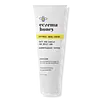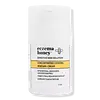What's inside
What's inside
 Key Ingredients
Key Ingredients

 Benefits
Benefits

 Concerns
Concerns

 Ingredients Side-by-side
Ingredients Side-by-side

Water
Skin ConditioningGlycerin
HumectantGlyceryl Stearate
EmollientTheobroma Cacao Seed Butter
EmollientButyrospermum Parkii Butter
Skin ConditioningCetearyl Olivate
Aloe Barbadensis Leaf Juice
Skin ConditioningCetearyl Alcohol
EmollientSorbitan Olivate
EmulsifyingColloidal Oatmeal
AbsorbentStearic Acid
CleansingCaprylic/Capric Triglyceride
MaskingHoney
HumectantXanthan Gum
EmulsifyingTocopherol
AntioxidantHelianthus Annuus Seed Oil
EmollientSodium Hyaluronate
HumectantChamomilla Recutita Oil
MaskingCalendula Officinalis Extract
Skin ConditioningWater, Glycerin, Glyceryl Stearate, Theobroma Cacao Seed Butter, Butyrospermum Parkii Butter, Cetearyl Olivate, Aloe Barbadensis Leaf Juice, Cetearyl Alcohol, Sorbitan Olivate, Colloidal Oatmeal, Stearic Acid, Caprylic/Capric Triglyceride, Honey, Xanthan Gum, Tocopherol, Helianthus Annuus Seed Oil, Sodium Hyaluronate, Chamomilla Recutita Oil, Calendula Officinalis Extract
Water
Skin ConditioningSqualane
EmollientC12-15 Alkyl Benzoate
AntimicrobialCaprylic/Capric Triglyceride
MaskingGlycerin
HumectantDimethicone
EmollientAloe Barbadensis Leaf Juice
Skin ConditioningButyrospermum Parkii Nut Extract
EmollientCetearyl Olivate
Sorbitan Olivate
EmulsifyingAvena Sativa Kernel Flour
AbrasiveCetearyl Alcohol
EmollientDicaprylyl Ether
EmollientSafflower Seed Oil Piperonyl Esters
Skin ConditioningDipotassium Glycyrrhizate
HumectantNiacinamide
SmoothingHoney
HumectantCetyl Palmitate
EmollientSorbitan Palmitate
EmulsifyingBakuchiol
AntimicrobialAdenosine
Skin ConditioningResveratrol
AntioxidantRetinal
Skin ConditioningCaprylyl Glycol
EmollientEthylhexylglycerin
Skin ConditioningHexylene Glycol
EmulsifyingEthylhexyl Palmitate
EmollientSilica Dimethyl Silylate
EmollientButylene Glycol
HumectantPentylene Glycol
Skin ConditioningSodium Hyaluronate
HumectantOlea Europaea Leaf Extract
PerfumingFructose
HumectantSymphytum Officinale Leaf Extract
Skin ConditioningBuddleja Davidii Meristem Cell Culture
Skin ConditioningCyperus Papyrus Leaf Cell Extract
AntioxidantCamellia Sinensis Leaf Extract
AntimicrobialSodium Hyaluronate Crosspolymer
HumectantSodium Palmitoyl Proline
Skin ConditioningNymphaea Alba Flower Extract
Skin ConditioningSea Water
HumectantLaminaria Digitata Extract
Skin ProtectingChlorella Vulgaris Extract
Skin ConditioningSaccharide Isomerate
HumectantPolyacrylamide
C13-14 Isoparaffin
EmollientLaureth-7
EmulsifyingTocopherol
AntioxidantXanthan Gum
EmulsifyingSodium Hydroxide
BufferingCitric Acid
BufferingDipropylene Glycol
HumectantPhenoxyethanol
PreservativeSodium Benzoate
MaskingPotassium Sorbate
PreservativeBenzoic Acid
MaskingWater, Squalane, C12-15 Alkyl Benzoate, Caprylic/Capric Triglyceride, Glycerin, Dimethicone, Aloe Barbadensis Leaf Juice, Butyrospermum Parkii Nut Extract, Cetearyl Olivate, Sorbitan Olivate, Avena Sativa Kernel Flour, Cetearyl Alcohol, Dicaprylyl Ether, Safflower Seed Oil Piperonyl Esters, Dipotassium Glycyrrhizate, Niacinamide, Honey, Cetyl Palmitate, Sorbitan Palmitate, Bakuchiol, Adenosine, Resveratrol, Retinal, Caprylyl Glycol, Ethylhexylglycerin, Hexylene Glycol, Ethylhexyl Palmitate, Silica Dimethyl Silylate, Butylene Glycol, Pentylene Glycol, Sodium Hyaluronate, Olea Europaea Leaf Extract, Fructose, Symphytum Officinale Leaf Extract, Buddleja Davidii Meristem Cell Culture, Cyperus Papyrus Leaf Cell Extract, Camellia Sinensis Leaf Extract, Sodium Hyaluronate Crosspolymer, Sodium Palmitoyl Proline, Nymphaea Alba Flower Extract, Sea Water, Laminaria Digitata Extract, Chlorella Vulgaris Extract, Saccharide Isomerate, Polyacrylamide, C13-14 Isoparaffin, Laureth-7, Tocopherol, Xanthan Gum, Sodium Hydroxide, Citric Acid, Dipropylene Glycol, Phenoxyethanol, Sodium Benzoate, Potassium Sorbate, Benzoic Acid
Ingredients Explained
These ingredients are found in both products.
Ingredients higher up in an ingredient list are typically present in a larger amount.
Aloe Barbadensis Leaf Juice comes from leaves of the aloe plant. Aloe Barbadensis Leaf Juice is best known for helping to soothe sunburns. It is also anti-inflammatory, moisturizing, antiseptic, and can help heal wounds.
Aloe is packed with good stuff including Vitamins A, C, and E. These vitamins are antioxidants, which help fight free-radicals and the damage they may cause. Free-radicals are molecules that may damage your skin cells, such as pollution.
Aloe Barbadensis Leaf Juice also contains sugars. These sugars come in the form of monosaccharides and polysaccharides, folic acid, and choline. These sugars are able to help bind moisture to skin.
It also contains minerals such as calcium, 12 anthraquinones, fatty acids, amino acids, and Vitamin B12.
Learn more about Aloe Barbadensis Leaf JuiceThis ingredient is an emollient, solvent, and texture enhancer. It is considered a skin-softener by helping the skin prevent moisture loss.
It helps thicken a product's formula and makes it easier to spread by dissolving clumping compounds.
Caprylic Triglyceride is made by combining glycerin with coconut oil, forming a clear liquid.
While there is an assumption Caprylic Triglyceride can clog pores due to it being derived from coconut oil, there is no research supporting this.
Learn more about Caprylic/Capric TriglycerideCetearyl alcohol is a mixture of two fatty alcohols: cetyl alcohol and stearyl alcohol. It is mainly used as an emulsifier. Emulsifiers help prevent the separation of oils and products. Due to its composition, it can also be used to thicken a product or help create foam.
Cetearyl alcohol is an emollient. Emollients help soothe and hydrate the skin by trapping moisture.
Studies show Cetearyl alcohol is non-toxic and non-irritating. The FDA allows products labeled "alcohol-free" to have fatty alcohols.
This ingredient is usually derived from plant oils such as palm, vegetable, or coconut oils. There is debate on whether this ingredient will cause acne.
Due to the fatty acid base, this ingredient may not be Malassezia folliculitis safe.
Learn more about Cetearyl AlcoholCetearyl Olivate is an emulsifier and texture enhancer. It is derived from the fatty acids of olive oil and Cetearyl alcohol, and is biodegradable.
As an emulsifier, it is used to prevent oils and waters from separating. It can also
Manufacturers use the name Olivem 1000. This ingredient has been found to preserve the natural microbiome of skin. Having a healthy microbiome helps keep our skin healthy and protects against harmful bacteria. This ingredient is grouped with Sorbitan Olivate under the name Olivem 1000.
Learn more about Cetearyl OlivateGlycerin is already naturally found in your skin. It helps moisturize and protect your skin.
A study from 2016 found glycerin to be more effective as a humectant than AHAs and hyaluronic acid.
As a humectant, it helps the skin stay hydrated by pulling moisture to your skin. The low molecular weight of glycerin allows it to pull moisture into the deeper layers of your skin.
Hydrated skin improves your skin barrier; Your skin barrier helps protect against irritants and bacteria.
Glycerin has also been found to have antimicrobial and antiviral properties. Due to these properties, glycerin is often used in wound and burn treatments.
In cosmetics, glycerin is usually derived from plants such as soybean or palm. However, it can also be sourced from animals, such as tallow or animal fat.
This ingredient is organic, colorless, odorless, and non-toxic.
Glycerin is the name for this ingredient in American English. British English uses Glycerol/Glycerine.
Learn more about GlycerinHoney comes from bees. It is mainly made up of the sugars fructose and glucose.
Besides sugar, honey also contains amino acids, peptides, Vitamins A, C, and E. Vitamins A, C, and E.
As a humectant, honey is great at hydrating the skin. Humectants draw moisture from the air and hold it to your skin.
Honey also has antioxidant and antioxidant properties. Fun fact: darker honey has more antioxidants than light honey.
The antibacterial property of honey may make it effective at helping to treat acne. We recommend speaking with a professional if you have concerns.
Many people wonder if honey is vegan. It is technically a byproduct from bees. This is because honey is created from the digestive enzymes in a bee's stomach.
Remember to be kind to bees :) They are important for many ecosystems and are endangered.
Learn more about HoneySodium Hyaluronate is hyaluronic acid's salt form. It is commonly derived from the sodium salt of hyaluronic acid.
Like hyaluronic acid, it is great at holding water and acts as a humectant. This makes it a great skin hydrating ingredient.
Sodium Hyaluronate is naturally occurring in our bodies and is mostly found in eye fluid and joints.
These are some other common types of Hyaluronic Acid:
Learn more about Sodium HyaluronateSorbitan Olivate is created from the fatty acids in olive oil and sorbitol.
This ingredient is an oil in water emulsifier. It helps stabilize a product by preventing oils and waters from separating. Sorbitan Olivate also helps hydrate the skin.
Manufacturers sell sorbitan olivate under the name OliveM 1000. OliveM 1000 a multifunctional ingredient. It is self-emulsifying. According to a manufacturer, OliveM 1000 does not disrupt natural skin biome.
Due to its olive oil base, this ingredient may not be fungal-acne safe.
Learn more about Sorbitan OlivateTocopherol (also known as Vitamin E) is a common antioxidant used to help protect the skin from free-radicals and strengthen the skin barrier. It's also fat soluble - this means our skin is great at absorbing it.
Vitamin E also helps keep your natural skin lipids healthy. Your lipid skin barrier naturally consists of lipids, ceramides, and fatty acids. Vitamin E offers extra protection for your skin’s lipid barrier, keeping your skin healthy and nourished.
Another benefit is a bit of UV protection. Vitamin E helps reduce the damage caused by UVB rays. (It should not replace your sunscreen). Combining it with Vitamin C can decrease sunburned cells and hyperpigmentation after UV exposure.
You might have noticed Vitamin E + C often paired together. This is because it is great at stabilizing Vitamin C. Using the two together helps increase the effectiveness of both ingredients.
There are often claims that Vitamin E can reduce/prevent scarring, but these claims haven't been confirmed by scientific research.
Learn more about TocopherolWater. It's the most common cosmetic ingredient of all. You'll usually see it at the top of ingredient lists, meaning that it makes up the largest part of the product.
So why is it so popular? Water most often acts as a solvent - this means that it helps dissolve other ingredients into the formulation.
You'll also recognize water as that liquid we all need to stay alive. If you see this, drink a glass of water. Stay hydrated!
Learn more about WaterXanthan gum is used as a stabilizer and thickener within cosmetic products. It helps give products a sticky, thick feeling - preventing them from being too runny.
On the technical side of things, xanthan gum is a polysaccharide - a combination consisting of multiple sugar molecules bonded together.
Xanthan gum is a pretty common and great ingredient. It is a natural, non-toxic, non-irritating ingredient that is also commonly used in food products.
Learn more about Xanthan Gum